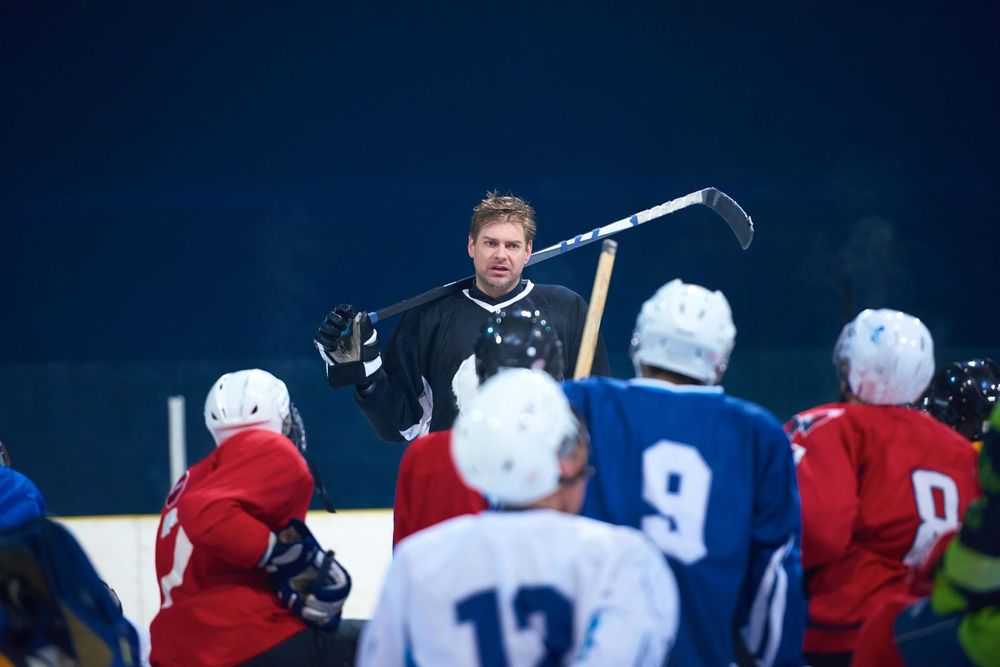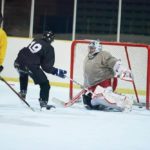In the world of minor hockey, trainers serve as the unsung heroes, safeguarding the well-being and safety of players. With their expertise in injury management and a deep understanding of the game, trainers play a vital role in ensuring a secure environment for all participants.
From promoting safety measures to addressing crucial issues like substance abuse and nutrition, trainers are the backbone of hockey safety. They work tirelessly to educate players about the importance of proper equipment and techniques to prevent injuries. Trainers are also responsible for assessing and treating injuries that occur during games and practices, providing immediate care and making informed decisions about the player’s ability to continue playing.
In addition to physical safety, trainers also play a crucial role in addressing mental and emotional well-being. They work closely with players to identify and manage issues like substance abuse, stress, and anxiety. Trainers provide a supportive and confidential environment for players to seek help and guidance.
Moreover, trainers are instrumental in educating players and their families about proper nutrition and hydration. They ensure that players have the knowledge and resources to fuel their bodies effectively for optimal performance and recovery.
Join us as we delve into the significance and responsibilities of trainers in this minor hockey community. Together, let’s recognize and appreciate the invaluable contributions they make to the safety and well-being of young hockey players.
Importance of Trainers in Hockey Safety
Trainers play a crucial role in ensuring the safety of players in minor hockey by prioritizing injury prevention and proper management. Their importance lies in their ability to enhance player safety through their expertise in injury prevention techniques and their knowledge of proper injury management.
Trainers are responsible for creating a safe environment on and off the ice, developing risk management plans, and implementing emergency action plans. They also play a key role in educating players about proper conditioning, stretching, and warm-up techniques, as well as promoting proper nutrition and discouraging the use of performance-enhancing substances, drugs, alcohol, and smoking.
Trainers are also responsible for managing minor injuries, recognizing and taking immediate action for life-threatening injuries, and making decisions regarding player return to play. Their presence and expertise are vital in ensuring the safety and well-being of players in minor hockey.
Role of Trainers in Injury Prevention
Enhancing player safety through their expertise in injury prevention techniques and knowledge of proper injury management, trainers in minor hockey play a crucial role in preventing injuries. Trainers have a significant impact on player performance and development, as they ensure that players are physically prepared and equipped to participate in the sport safely.
Trainers’ impact on player performance:
- Implementing proper conditioning, stretching, and warm-up techniques to enhance players’ physical abilities and reduce the risk of injuries.
- Educating players about the importance of proper nutrition, which can improve performance and aid in injury prevention.
Trainers’ role in player development:
- Developing and implementing risk management plans to create a safe environment for players to grow and progress in their skills.
- Ensuring the presence of well-stocked medical kits and accurate medical history files, allowing trainers to make informed decisions regarding player development and injury management.
Enhancing Safety for Players and Participants
By ensuring the well-being of players and participants in minor hockey, trainers play a pivotal role in creating a safe and secure environment for everyone involved. Trainers are equipped with the knowledge and expertise to implement effective training techniques and injury prevention measures. They prioritize safety on and off the ice, making it their primary responsibility.
Trainers must possess Standard First Aid and CPR certification, and their presence on the bench is becoming a requirement at all age levels. They carry out various responsibilities, including developing risk management plans, creating emergency action plans, and promoting fair play through equipment checks. Trainers also educate players on proper conditioning, stretching, and warm-up techniques, as well as proper nutrition and the dangers of performance-enhancing substances.
They play a crucial role in injury management, making decisions on player return to play and being prepared for emergencies. Overall, trainers are instrumental in enhancing safety for players and participants in minor hockey.
Primary Responsibility: Safety on and off the Ice
Ensuring safety on and off the ice is the foremost duty of trainers in minor hockey. Trainers play a crucial role in promoting player well-being and creating a safe environment for all participants. Here are the key responsibilities of trainers in terms of off-ice safety:
- Risk Management: Trainers are responsible for developing and implementing a risk management plan to minimize potential hazards during team activities. This includes ensuring safe premises and practicing an Emergency Action Plan.
- Education: Trainers educate players on proper conditioning, stretching, and warm-up techniques to prevent injuries. They also promote healthy nutritional regimens and provide education on the dangers of performance-enhancing substances, drugs, alcohol, and smoking.
- Document Management: Trainers maintain accurate medical history files for players and ensure the presence of important documents and well-stocked medical kits for emergencies.
Trainers’ Certification and Requirements
Trainers in minor hockey must meet specific certification and requirements to ensure player safety and well-being. The role of trainers in player safety is crucial, as they are responsible for the prevention and proper management of injuries. Trainers prioritize safety on and off the ice, and their presence is becoming a requirement at all age levels.
To become a certified trainer, individuals must possess Standard First Aid and CPR certification. However, training alone is not enough; trainers must be present on the bench during games and practices. The certification levels of trainers may vary, but their knowledge and skills in injury management techniques are essential.
Trainers also have key responsibilities such as implementing risk management plans, promoting fair play, and creating emergency action plans. Additionally, they educate players on safety practices, proper nutrition, and the dangers of substance abuse.
In injury management, trainers assess and manage minor injuries, make decisions on player return to play, and are prepared to handle emergencies. By meeting these certification requirements and fulfilling their role in player safety, trainers contribute to a safe and enjoyable hockey experience for all participants.
Standard First Aid and CPR Certification
To ensure the safety and well-being of players in minor hockey, trainers must possess the essential certification of Standard First Aid and CPR. This certification is crucial in equipping trainers with the necessary skills and knowledge to handle medical emergencies and provide immediate care in the event of an injury on the ice.
Here are two key reasons why standard first aid training and CPR certification are essential for trainers:
- Emergency Response: Trainers with standard first aid training and CPR certification can effectively respond to medical emergencies such as cardiac arrest, choking, or severe injuries. They can quickly assess the situation, provide appropriate first aid measures, and perform CPR if necessary, significantly increasing the chances of survival.
- Injury Management: Trainers equipped with standard first aid training can properly manage minor injuries on the spot, reducing the risk of complications and ensuring players receive timely and appropriate care. They can also make informed decisions regarding player return to play, prioritizing player safety and minimizing the risk of further injury.
Trainers Must Be Present on the Bench
Having a certified trainer present on the bench is an essential requirement for ensuring the safety and well-being of players in minor hockey. Trainers play a crucial role in player well-being, as they are responsible for managing injuries, providing immediate medical attention, and making informed decisions regarding player participation.
The presence of a trainer on the bench has a significant impact on player performance. Trainers are trained to recognize and address potential risks, implement injury prevention strategies, and ensure that players are physically prepared for the game. They also play a key role in educating players about proper conditioning, nutrition, and injury management techniques.
Trainers’ Requirement at All Age Levels
Ensuring the presence of a certified trainer on the bench is a fundamental requirement for maintaining player safety and well-being at all age levels in minor hockey. Trainers play a crucial role in player development, as they not only prioritize safety but also contribute to the overall performance of the team.
Trainers’ role in player development:
- They educate players on proper conditioning, stretching, and warm-up techniques, which enhance performance and reduce the risk of injuries.
- Trainers promote proper nutritional regimens, educating players on the importance of a healthy diet for optimal performance.
Trainers’ impact on team performance:
- By implementing a risk management plan and practicing an Emergency Action Plan, trainers create a safe environment where players can focus on their game.
- Through injury management and player return protocols, trainers ensure that injured players receive the appropriate care, allowing the team to maintain its competitive edge.
With their expertise and dedication, trainers contribute not only to the safety of the players but also to their development and the success of the team as a whole.
Varying Levels of Certification in Injury Management
The certification levels in injury management vary, highlighting the importance of qualified trainers in minor hockey for ensuring player safety and effective injury care.
Trainers play a crucial role in minor hockey, as they are responsible for the prevention, management, and treatment of injuries that occur on and off the ice.
The levels of certification in injury management vary, with trainers needing to possess Standard First Aid and CPR certification as a minimum requirement. However, the knowledge and techniques taught in these certifications can vary, and trainers with higher levels of certification have a deeper understanding of injury management. This allows them to make informed decisions on player return to play and prioritize player safety.
Having trainers with varying levels of certification ensures that minor hockey teams have access to the appropriate level of injury care and expertise.
Carrying Out the Role in Game Situations
During game situations, trainers in minor hockey play a crucial role in ensuring player safety and effectively managing injuries. Carrying out their role effectively can be challenging due to the fast-paced nature of the game and the potential for various types of injuries.
Some of the challenges faced by trainers include:
- Quick assessment and response:
- Trainers need to be able to quickly assess the severity of an injury and provide immediate care or refer the player to appropriate medical professionals.
- Communication and coordination:
- Trainers must effectively communicate with coaches, players, and medical staff to ensure everyone is aware of the injury and the necessary steps for treatment and recovery.
- Emotional support:
- Trainers play a vital role in providing emotional support to injured players and their families, helping them navigate the physical and emotional challenges of an injury.
- Pressure and time constraints:
- Trainers often face the pressure of making quick decisions regarding player safety while adhering to time constraints imposed by the game.
Despite these challenges, trainers strive to carry out their role effectively, prioritizing player safety and ensuring a safe and enjoyable hockey experience for all.
Developing and Implementing a Risk Management Plan
To effectively manage player safety and mitigate potential risks, trainers in minor hockey must develop and implement a comprehensive risk management plan.
This plan should include risk management protocols and injury prevention strategies tailored to the specific needs of the team and its players. By identifying potential risks and implementing strategies to minimize them, trainers can create a safer environment for the players to participate in the sport.
Risk management protocols should outline procedures for identifying and addressing potential risks, such as regular equipment checks and ensuring safe playing surfaces.
Injury prevention strategies should focus on promoting proper conditioning, stretching, and warm-up techniques, as well as educating players about the dangers of performance-enhancing substances, drugs, alcohol, and smoking.
Ensuring Safe Premises for Team Activities
Trainers in minor hockey ensure the safety of team activities by maintaining secure premises. They play a crucial role in creating a safe environment for players and participants. To achieve this, trainers focus on two key aspects:
- Safe equipment:
- Regularly inspecting and maintaining all hockey equipment, such as helmets, pads, and skates, to ensure they are in good working condition.
- Educating players and coaches on the importance of wearing properly fitted equipment to prevent injuries.
- Emergency preparedness:
- Developing and practicing an Emergency Action Plan to respond effectively to any medical emergencies or accidents that may occur during team activities.
- Ensuring that medical kits are well-stocked and easily accessible at all times.
Creating an Emergency Action Plan
The implementation of an Emergency Action Plan is essential for ensuring the safety and preparedness of trainers in minor hockey. This plan outlines the necessary steps and procedures that trainers should follow in the event of an emergency.
It is crucial for trainers to have a clear understanding of the importance of communication and the emergency response procedures in order to effectively manage and respond to any potential emergencies that may arise during practices or games.
By having a well-developed Emergency Action Plan in place, trainers can ensure the safety of players, coaches, and other team personnel. This includes knowing how to handle injuries, providing immediate medical attention, and coordinating with emergency services if needed.
Regular practice and familiarization with the plan are also important to ensure a quick and efficient response in any emergency situation.
Promoting Fair Play and Conducting Equipment Checks
Promoting fair play and ensuring equipment compliance are crucial aspects of trainers’ responsibilities in minor hockey. Trainers play a vital role in creating a safe and sportsmanlike environment for players. Here are some key points to consider:
- Equipment inspection:
- Trainers should regularly inspect players’ equipment to ensure it meets safety standards.
- They need to check for proper fitting and functionality of helmets, face masks, mouthguards, and other protective gear.
- Promoting sportsmanship:
- Trainers should educate players about the importance of fair play, respect, and good sportsmanship.
- They should encourage players to follow the rules, treat opponents with respect, and display positive attitudes both on and off the ice.
Educating and Promoting Safety Measures
One crucial aspect of trainers’ role in minor hockey is imparting knowledge and advocating for safety measures. Trainers play a vital role in educating players about proper conditioning techniques, which include stretching, warm-up exercises, and overall physical fitness. By promoting these techniques, trainers aim to minimize the risk of injuries and enhance players’ performance on the ice. Additionally, trainers emphasize the importance of proper nutritional regimens for players, ensuring they understand the impact of diet on their overall health and athletic abilities. They educate players about the dangers of performance-enhancing substances, drugs, alcohol, and smoking, fostering a culture of responsibility and well-being. By prioritizing safety and well-being through education, trainers create an environment where players can thrive and belong.
| Proper Conditioning Techniques | Promoting Nutritional Regimens | Educating Players |
|---|---|---|
| Stretching exercises | Balanced diets | Dangers of substance abuse |
| Warm-up routines | Hydration importance | Healthy lifestyle choices |
| Strength training | Meal planning | Impact of smoking and alcohol |
| Injury prevention exercises | Nutrient timing | Performance-enhancing substances |
Frequently Asked Questions
What Are Some Examples of Performance-Enhancing Substances That Trainers Educate Players About?
Trainers play a crucial role in educating players about performance-enhancing substances, ensuring their safety during games. They promote awareness of substances such as steroids, stimulants, and hormone treatments, emphasizing the importance of fair play and maintaining a healthy lifestyle.
How Do Trainers Prioritize Player Safety During Game Situations Without a Trainer Present?
Trainers prioritize player safety during game situations without a trainer present by implementing effective communication strategies, emphasizing injury prevention techniques, and ensuring players are aware of safety protocols. They also promote fair play and conduct regular equipment checks.
What Factors Do Trainers Consider When Making Decisions on a Player’s Return to Play After an Injury?
Trainers consider several factors when making decisions on a player’s return to play after an injury. These include the nature and severity of the injury, the player’s recovery progress, medical advice, and the overall safety and well-being of the player.
What Are Some Examples of Minor Injuries That Trainers Are Able to Manage on Their Own?
Trainers play a crucial role in managing minor injuries in hockey. They possess the knowledge and skills to handle common injuries such as sprains, strains, and minor cuts. Effective communication with coaches ensures appropriate player management and safety.
How Do Trainers Recognize and Take Immediate Action for Life-Threatening Injuries?
Trainers in minor hockey recognize life-threatening injuries by being vigilant and knowledgeable about signs and symptoms. They take immediate action by activating emergency protocols, providing basic life support, and contacting medical professionals for timely intervention and treatment.
Conclusion
In conclusion, trainers play an essential role in ensuring the safety and well-being of hockey players.
Their primary responsibility is to promote safety on and off the ice, and they are crucial team officials who prioritize the welfare of players and participants.
Through their certification in Standard First Aid and CPR and their expertise in injury management, trainers enhance safety by educating players, addressing key issues, and making important decisions regarding player return to play.
Their presence and knowledge contribute significantly to the overall safety of the sport.









